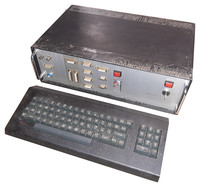Tangerine Microtan 65
| Home > Browse Our Collection > Computers > Tangerine Computer Systems > Tangerine Microtan 65 |
|
The Microtan 65 was one of the first 6502-based kit computers, produced by Tangerine Computer Systems and released in 1979. Alongside the 6502 processor the board features 1K of RAM, 1K of monitor ROM, VDU and a keyboard interface. The 1K monitor, TANBUG, offers memory and register, examine, modify and list, block moves, single instruction, multiple non-destructive breakpoints with ability for multiple passes, address offset calculation and many other features. The board also features a UHF modulator, allowing you to connect it to a TV screen. The manual came with a one-kilobyte listing of Conway's Game of Life. An optional expansion board could be built with a UART, more memory and BASIC ROMs. Additional expansion boards, such as TANEX, became available later, offering more RAM, dedicated serial and parallel I/O boards, etc. The Microtan 65 was intended as a general purpose microcomputer which could be used by laboratories, Original Equipment Manufacturers (OEMs), and the computer enthusiast. The computer was designed to be expandable. This way the customer could customise the system, be it as a specialised control system, as a learning tool, or as a general purpose computing device. Price of the Microtan 65 board in 1981 was £79.35 (inc. VAT) in kit form or £90.85 ready-assembled. The system was not generally available in the shops, one of the few stockists at the time being Henry's Radio of Edgware Road, London. To accompany the hardware and to offer further support to users, a magazine was created, the Tansoft Gazette. This was edited by Tangerine employee Paul Kaufman who continued as editor when the magazine was renamed Oric Owner. Tansoft also became the name of Tangerine Computer's official software house which supplied a number of software products and book for the Microtan system and subsequently for the Oric range of computers. The major advance that the Microtan 65 had over a lot of the competition at that time was that the video display was flicker free. At the time a lot of microcomputers would either access the screen memory asynchronously to the video timing (causing flicker and splats on the screen), or would write to the screen memory during a non-display period (which was slow). The Microtan 65 got over this problem by making use of an incidental feature of the 6502. The 6502, unlike most other CPUs, has a regular period in each instruction cycle when all CPU activity is inside the chip, leaving the external memory available without using complex external arbitration logic. This made video display design simpler and meant that video accesses could be made at maximum speed. This technique is also used on the Oric-1 and Atmos, and in the unrelated Apple II. The 32×16 characters was the reason that the 6502 was clocked at 750 kHz. To get the circuitry to work at a (nearly) standard video rate meant that the pixel clock had to be 6 MHz. When the Microtan 65 was designed only a 1 MHz 6502 was available, and so 750 kHz was used (6 MHz divided by 8). After the Microtan 65, Tangerine planned to build a desktop machine and managed to get as far as selling the design for the Microtan 2 also known as Tangerine Tiger to HH Electronics, better known for building amplifiers. They released it as the HH Tiger, but it was not a commercial success. Tangerine's successor to the Microtan 65 was the Oric-1 which was released in 1983. Our Microtan 65 system is a home customised system as can be seen by the picture but with the original Microtan keyboard and was very kindly donated by Chris Owens. Manufacturer: Tangerine Computer Systems Comment on This Page This exhibit has a reference ID of CH23946. Please quote this reference ID in any communication with the Centre for Computing History. |
|


























